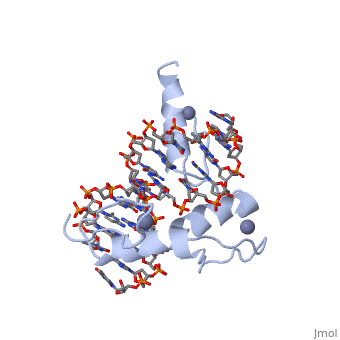Proteopedia:Demo1
This page aims to quickly demonstrate some of the features available in Proteopedia pages:
- Text, images, as well as videos embedded in the page.
- Hyperlinks, both to other pages within Proteopedia and to external pages.
- Molecular models that are 3D, animated and interactive.
- The green links, specific to Proteopedia. These serve to act on the displayed molecular model, changing it to a new molecular scene.
The zinc finger motif in proteinsThe zinc finger motif in proteins
The term "motif" when used in structural biology tends to refer to one of two cases:
There are a great number of protein sequence motifs identified, many of which have well defined structural or functional roles. One such example is the so-called zinc finger motif which is readily identified from the following consensus sequence pattern (where "X" represents any amino acid): Cys - X(2-4) - Cys - X(3) - Phe - X(5) - Leu - X(2) - His - X(3) - His
The example structure, displayed to the right, that serves to is that of Zif268 protein-DNA complex from Mus musculus. In this example (a C2H2 class zinc finger) the conserved and residues form ligands to a whose coordination is essential to stabilise the tertiary fold of the protein. The fold is important because it helps orientate the to bind to the . You can watch an explanation in this video:
|
| ||||||||||||
See alsoSee also
AcknowledgementAcknowledgement
This page was based on content from User:James D Watson/Structural Templates
